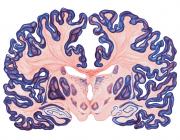Texture segregation in the human visual cortex: A functional MRI study.
Publication Year
2000
Type
Journal Article
Abstract
The segregation of visual scenes based on contour information is a fundamental process of early vision. Contours can be defined by simple cues, such as luminance, as well as by more complex cues, such as texture. Single-cell recording studies in monkeys suggest that the neural processing of complex contours starts as early as primary visual cortex. Additionally, lesion studies in monkeys indicate an important contribution of higher order areas to these processes. Using functional MRI, we have investigated the level at which neural correlates of texture segregation can be found in the human visual cortex. Activity evoked by line textures, with and without texture-defined boundaries, was compared in five healthy subjects. Areas V1, V2/VP, V4, TEO, and V3A were activated by both kinds of line textures as compared with blank presentations. Textures with boundaries forming a checkerboard pattern, relative to uniform textures, evoked significantly more activity in areas V4, TEO, less reliably in V3A, but not in V1 or V2/VP. These results provide evidence that higher order areas with large receptive fields play an important role in the segregation of visual scenes based on texture-defined boundaries.
Keywords
Journal
J Neurophysiol
Volume
83
Pages
2453-7
Date Published
04/2000
ISSN Number
0022-3077
Alternate Journal
J. Neurophysiol.
PMID
10758146

